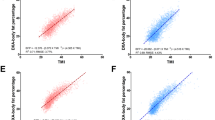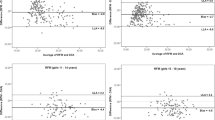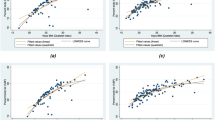Abstract
In the present study, we measured body composition of boys and girls aged 3–5 years and investigated changes with age. We also composed regression polynomials of body weight against height from the data and the data for young children obtained similarly in the present study, determined the valid order for the polynomial, and developed a regression evaluation. Obesity was determined from the regression evaluation for body weight against height and compared with obesity determined from the body fat percentages obtained in this study to investigate the validity of body composition measurements of young children. A comparison was then made of children whose fat-thin level was judged from height and weight in this way and determinations of fat-thin level judged from statistical values for fat percentage measured in this study. In boys both distributions show essentially the same trends, whereas in girls the distribution shows a marked change toward “somewhat thin”. Fat percentage judgements were more common in “somewhat thin”, and overall there was a greater trend toward obesity in judgements from weight vs. height regression evaluation charts.
Similar content being viewed by others
References
Akimaru T (2003) A change and problems of physique and exercise ability in preschool children during 30 years. J Growth Dev Child 1:128–132 [in Japanese]
Fujii K, Akimaru, Hanai T et al. (2005) An examination regarding annual change of physique and motor fitness in preschool children: analysis regarding girls by polynomial. Educ Health Sci 50:217–228 [in Japanese]
Fujii K, Akimaru T, Hanai T et al (2005) An examination regarding annual change of physique and motor fitness in preschool children by polynomial: analysis for boys. Tokai Annu Rep Health Phys Educ 27:9–20 [in Japanese]
Kondo M, Matsuda I, Sugihara T (1987) Motor fitness in preschool children, 1. From whole country investigation in 1986. J Health Phys Educ Rec 37:551–554 [in Japanese]
Kondo M, Matsuda I, Sugihara T (1987) Motor fitness in preschool children, 2. Comparison with investigation of 1986 and 1973. J Health Phys Educ Rec 37:624–628 [in Japanese]
Fujii K (2006) Scientic approaches to growth and development. Sankeisha, Nagoya, Japan
Fujii K, Akimaru T, Hanai T, Sakai T (2006) Confirmation regarding secular trend in growth and development of physique and motor fitness in preschool children: an approach from physical maturation rate. Jpn Phys Fitness Sports Med 55:489–502 [in Japanese]
Otogi K, Komiya S, Teramoto K et al (1999) Gender differences in body fat distribution of 3- to 6-year-old Japanese children. Jpn Phys Fitness Sports Med 48:641–650 [in Japanese]
Eto C, Komiya S, Otoki K, Teramoto K (2002) Annual changes in body fat of young Japanese children. Jpn J Physiol Appl Human Sci 7:55–61 [in Japanese]
Teramoto K, Otogi K, Komiya S (1999) Age-related changes body composition of 3- to 6-year-old Japanese children. J Physiol Anthropol 18:153–160
Fukunaga T (2003) The muscular strength development of children. J Growth Dev Child 1:78–84 [in Japanese]
Sugiyama M (2003) The development of body composition and physical growth in students of primary school and junior high school. J Growth Dev Child 1:268–274 [in Japanese]
Sakaida M, Fujii K, Akimaru T et al (2007) Relationship among body composition, and change of body composition and bone mineral density (SOS value) with age in preschool children. Jpn J Hum Growth Dev Res 35:1–9 [in Japanese]
Ito Y, Okuno A, Murakami Y et al (1996) Standard height-weight curve for the determination of obesity index in early childhood. J Child Health 55:752–756 [in Japanese]
Ito Y, Ueda O (2000) Height-weight curve and standard index for obesity in early childhood. J Jpn Soc Obesity 6:80–81 [in Japanese]
Matsuura Y, Kim M (1991) Analysis of physical growth by fitting the polynomial to the longitudinal growth distance data of individual; age 6 to 17. Research Monograph issued by Growth and Development Research Institute of Health and Sport Sciences, University of Tsukuba, Japan, pp 1–153
Largo RH, Gasser T, Prader A et al (1978) Analysis of the adolescent growth spurt using smoothing spline functions. Ann Hum Biol 5:421–434
Author information
Authors and Affiliations
Corresponding author
Rights and permissions
About this article
Cite this article
Sakai, T., Demura, S. & Fujii, K. Validity of fat percentage evaluation for fat-thin judgement derived from standard weight in preschool children. Sport Sci Health 5, 105–112 (2009). https://doi.org/10.1007/s11332-009-0085-7
Received:
Accepted:
Published:
Issue Date:
DOI: https://doi.org/10.1007/s11332-009-0085-7




